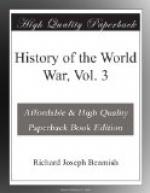Kut-el-Amara still remained, and early in August an expedition was directed against that point. The Turks were found in great force, well intrenched, and directed by German officers. The battle lasted for four days. The English suffered great hardship on account of the scarcity of water and the blinding heat, but on September 29th they drove the enemy from the city and took possession. More than two thousand prisoners were taken. The town was found thoroughly fortified, with an elaborate system of trenches extending for miles, built in the true German fashion. Its capture was the end of the summer campaign.
[Illustration: The Mesopotamian sector, where the British routed the Turkish army]
The British now had at last made up their minds to push on to Bagdad. General Townshend, whose work so far had been admirable, protested, but Sir John Nixon, and the Indian military authorities, were strongly in favor of the expedition. By October, Turkey was able to gather a large army. She was fighting in Transcaucasia, Egypt, Gallipoli and Mesopotamia. Little was going on in the first three of these fronts, and she was able therefore to send to Mesopotamia almost a quarter of a million men.
To meet these, General Townshend had barely fifteen thousand men, of whom only one-third were white soldiers. He was backed by a flotilla of boats of almost every kind,—river boats, motor launches, paddle steamers, native punts. The British army was almost worn out by the fighting during the intense heat of the previous summer. But their success had given them confidence.
In the early days of October the advance began. For some days it proceeded with no serious fighting. On the 23d of October it reached Azizie, and was halted by a Turkish force numbering about four thousand. These were soon routed, and the advance continued until General Townshend arrived at Lajj, about seven miles from Ctesiphon, where the Turks were found heavily intrenched and in great numbers. Ctesiphon was a famous old city which had been the battle ground of Romans and Parthians, but was now mainly ruins. In these ruins, however, the Turks found admirable shelter for nests of machine guns. On the 21st of November General Townshend made his attack.
The Turks occupied two lines of intrenchments, and had about twenty thousand men, the English about twelve thousand. General Townshend’s plan was to divide his army into three columns. The first was to attack the center of the first Turkish position. A second was directed at the left of that position, and a third was to swing widely around and come in on the rear of the Turkish force. This plan was entirely successful, but the Turkish army was not routed, and retreated fighting desperately to its second line. There it was reinforced and counter-attacked with such vigor that it drove the British back to




